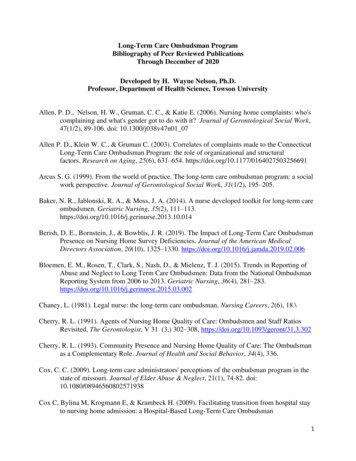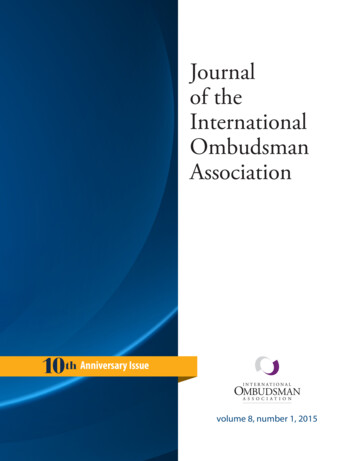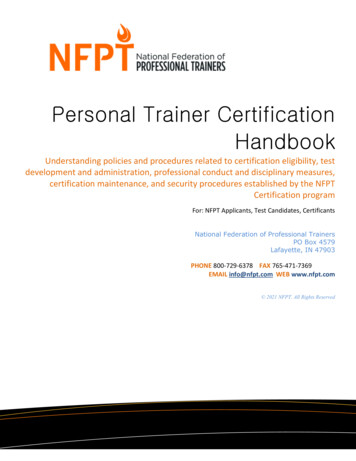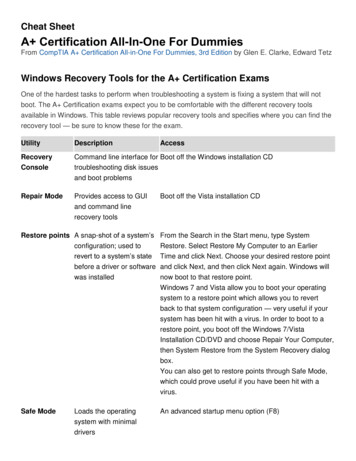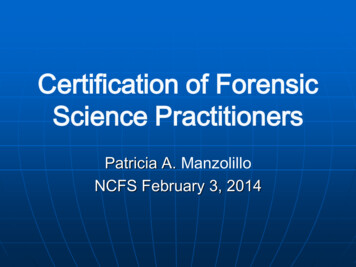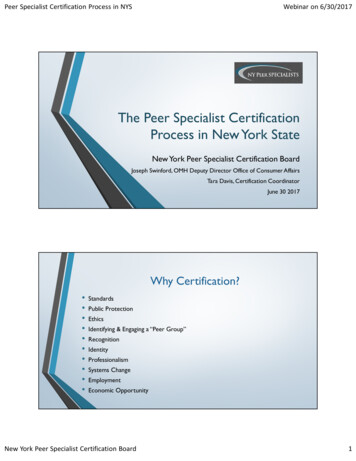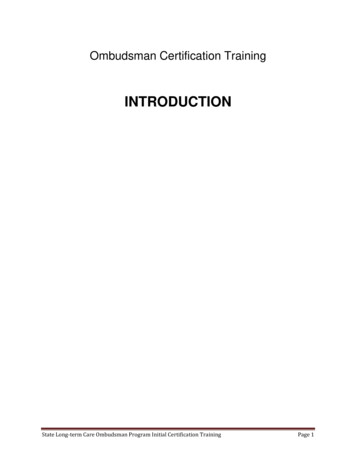
Transcription
Ombudsman Certification TrainingINTRODUCTIONState Long-term Care Ombudsman Program Initial Certification TrainingPage 1
State Long-term Care Ombudsman Program Initial Certification TrainingPage 2
Welcome to the Long-term Care Ombudsman ProgramThank you for choosing to serve as a Long-term Care Ombudsman. Long-term CareOmbudsmen serve as resident-directed advocates in nursing homes and assisted livingfacilities. Some residents may need help to improve their quality of life and care. As anombudsman, you provide assistance and advocacy so everyone receives respectful andcompetent care.What does an ombudsman do?Ombudsmen investigate complaints, report findings, and help achieve resolutions. Theycan help one person resolve a problem, address issues that affect several residents, orwork to change a systemic problem.Ombudsmen serve residents of nursing homes and assisted living facilities in thefollowing ways:Handle complaints and problem-solveAn ombudsman supports residents and families to resolve any complaints bydefining concerns, explaining rights, and identifying possible courses of action. Inall situations, confidentiality is maintained and no information is released withoutpermission of the resident or decision-maker.Provide information and assistanceAn ombudsman is a good source of information about selecting a long-term carefacility, residents’ rights, and how long-term care facilities operate.Advocate for system and legislative changesState and local ombudsman programs work cooperatively to recommendregulatory and legislative changes that affect older Texans.Training Requirements:Ombudsmen must complete a 36-hour certification training which includes: at least 12 hours of classroom training; at least 2 in-facility training sessions (provided through on-the-job trainingcalled shadow visits); maximum of 20 hours of self-study assignments; and volunteers complete a three month internship.Other Requirements A sincere interest in promoting the well-being and protecting the rights ofpeople in long-term care facilitiesAn ability to work cooperatively with the people who live in nursing homesand assisted living facilities, local staff ombudsmen, and long-term careprovidersState Long-term Care Ombudsman Program Initial Certification TrainingPage 3
Ability to discover facts, work to resolve complaints, and impartially andobjectively determine whether complaints are verified or notAcceptance of, and adherence to, the Texas Long-term Care OmbudsmanProgram (LTCOP) Code of EthicsSuccessful completion of Texas LTCOP training program and approval of thelocal Managing Local Ombudsman (MLO) and the State Ombudsman.Free of any conflict of interestWhat will I learn in training?Certification training prepares you to serve as an ombudsman. It includesinformation about the history of the program, laws and rules that direct ombudsmanwork, and the process of receiving, investigating, and resolving complaints made by,or on behalf of, residents of nursing homes and assisted living facilities.How do I get certified?After criminal history and conflict of interest screening, a person who applies to be avolunteer ombudsman is called an intern. After completing all training, a three month internship, and demonstrating the ability to apply ombudsman fundamentals,an MLO may recommend an intern to be certified. The State Ombudsman makesthe final decision.Let’s get started!Opening Exercise: Get AcquaintedUse the following introductory questions to familiarize class members with one another.Depending on the number of participants, the class may break into groups to completethe exercise. Take turns asking each other these questions:What is your name?Why are you interested in being an ombudsman?Have you visited a nursing home? Yes (Y) or No (N)Have you visited an assisted living facility? Yes (Y) or No (N)What were your impressions of the last one visited?State Long-term Care Ombudsman Program Initial Certification TrainingPage 4
Training Manual - Icons KeyQuestions about the reading aboveExerciseAsk the Trainer – DiscussionOmbudsman TipVery Important Information!Link to a website such as YouTube or FacebookConsultation RequiredMovie or Video ClipState Long-term Care Ombudsman Program Initial Certification TrainingPage 5
AcronymsAcronymsTermsAAAArea Agency on AgingADLActivity of Daily LivingADONAssistant Director of NursingALFAssisted Living FacilityANEAbuse, Neglect, and ExploitationAPSAdult Protective ServicesCMSCenters for Medicare and Medicaid ServicesCNACertified Nurse AssistantDONDirector of NursingDPOADurable Power of AttorneyHIPAAHealth Insurance Portability and Accountability ActHSCHealth and Safety CodeLARLegally Authorized Representative, such as a guardian, a parent, managingconservator of a minor, or an agent authorized under a power of attorneyLIDDALocal Intellectual and Developmental Disability AuthorityLTCLong-Term CareLMHALocal Mental Health AuthorityLTCOPLong-Term Care Ombudsman Program, i.e., a local ombudsman entityMCOManaged Care OrganizationMFPMoney Follows the PersonMLOManaging Local Ombudsman; is also a Certified OmbudsmanMOUMemorandum of UnderstandingMPOAMedical Power of AttorneyNFNursing FacilityOAAOlder Americans ActPASRRPreadmission Screening and Resident ReviewPOAPower of AttorneyQMPQuality Monitoring ProgramQRSQuality Reporting SystemRPResponsible PartyRSRegulatory ServicesSLTCOState Long-Term Care OmbudsmanSTAR PLUS Texas Medicaid Managed Care program (for people who have disabilities or are age65 or older)TACTexas Administrative CodeTMFTMF Health Quality InstituteVAVeteran AdministrationState Long-term Care Ombudsman Program Initial Certification TrainingPage 6
Ombudsman Certification TrainingCHAPTER 1: Long-term CareOmbudsman ProgramsState Long-term Care Ombudsman Program Initial Certification TrainingPage 7
State Long-term Care Ombudsman Program Initial Certification TrainingPage 8
Long-term Care Ombudsman ProgramsChapter 1 provides an understanding of the Texas Long-term Care OmbudsmanProgram, its purpose, unique aspects, and history.Learning Objectives Develop an understanding of the history and uniqueness of long-term careombudsman programsReview and follow the long-term care ombudsman responsibilitiesLearn why residents need advocates and how ombudsmen can respondContents How Long-term Care Ombudsman Programs BeganLong-term Care Ombudsman RoleWhy Do Residents Need Advocacy?Unique Aspects of Long-term Care Ombudsman ProgramLong-term Care Ombudsman ResponsibilitiesDVD(s), Supplements, Forms DVD: Advocates for Resident Rights: The Older Americans Act Long-term CareOmbudsman ProgramSupplement 1-A: Ombudsman Program MilestonesSupplement 1-B: Statutory and Rule ReferencesState Long-term Care Ombudsman Program Initial Certification TrainingPage 9
How Long-term Care Ombudsman Programs BeganIn 1965, Congress added Title XVIII - Medicare and Title XIX - Medicaid to the SocialSecurity Act. These programs laid the groundwork to regulate and reimburse thenursing home industry, and the number of nursing homes grew tremendously. Before,the government provided no public money as an incentive for private owners to buildfacilities. President Lyndon B. Johnson signed the Older Americans Act into law, whichset objectives to maintain the dignity and welfare of older adults and to create the agingnetwork for organizing, coordinating, and providing aging services.In the late 1960s and early 1970s, the government received reports of abuse, neglect,and substandard conditions in nursing homes. Congressional committees convened tohear testimonies, compile data, and propose reforms. Publicity attesting to poor careand personal profit for owners created a climate to enact specific federal regulations forstandards of care.In 1971, Dr. Arthur S. Flemming, U. S. Commissioner on Aging to President Nixon,developed the idea for the ombudsman program and envisioned it as an advocacyprogram for residents. He pitched the idea to the President on a trip on Air Force One.In 1978, long-term care ombudsman programs were established in the Older AmericansAct. Supplement 1-A provides a timeline of long-term care ombudsman programs.The Older Americans Act requires all state units on aging to establish an ombudsmanprogram to: investigate and resolve residents’ complaints;promote the development of citizens’ organizations and train volunteers;identify problems and work to resolve them;monitor development and implementation of federal, state, and local long-termcare laws and policies;gain access to nursing homes and assisted living facilities and to residents’records; andprotect confidentiality of residents’ records, complainants’ identities, andombudsman files.Each state has an office of the state long-term care ombudsman headed by a full-timestate long-term care ombudsman. In Texas, the office is an independent unit within astate health and human services agency. Patty Ducayet is the Texas State Long-termCare Ombudsman.State Long-term Care Ombudsman Program Initial Certification TrainingPage 10
The Managing Local Ombudsman is:Phone Number:.My supervising staff ombudsman isPhone Number:.The State contracts with 28 area agencies on aging (AAAs). Twenty-six AAAs operatelocal ombudsman programs and two AAAs subcontract the ombudsman program:Dallas County through The Senior Source and Harris County through the University ofTexas Health Sciences Center.The Older Americans Act connects advocacy services for individual residents with theresponsibility to publicly represent the needs of residents. Ombudsmen work to effectchange in laws, regulations, and policies, using individual complaints as the basis forchanging systems.Long-term Care Ombudsman RoleUnderstanding the history, development, and unique aspects of long-term careombudsman programs provides a foundation to understand the role of ombudsmen.Long-term care ombudsmen: Advocate for residents of nursing homes and assisted living facilities;Work with the families and friends of residents as well as facility staff who make acomplaint on behalf of a resident, even though ‘resident’ is used throughout thismanual;Provide information about how to select a facility and how to get quality care;Identify, investigate, and resolve problems;Represent the resident perspective in monitoring laws, regulations, and policies,and make recommendations about needed change; andPrevent abuse and neglect by educating residents and supporting them if theyneed to report it.As required by the federal Older Americans Act, long-term care ombudsman programsoperate in 50 states, the District of Columbia, Puerto Rico, and Guam. Many states,including Texas, use staff and volunteer ombudsmen to advocate for residents.State Long-term Care Ombudsman Program Initial Certification TrainingPage 11
Ombudsman Mission StatementThe Texas Long-term Care Ombudsman Program advocates for optimal quality of lifeand quality of care for residents in nursing homes and assisted living facilities.Residents and their families are served by developing and using the talents of speciallytrained volunteers and paid staff to represent the interests of residents who live innursing homes and assisted living facilities.Ombudsman PhilosophyPeople who are unable to care for themselves are entitled to dependable and consistentcare. Ombudsmen advocate for residents to enjoy quality of life and receive high qualitycare.Regulations pertaining to assisted living facilities do not directly address quality of life orcare. However, Texas Nursing Facility Requirements (NFR) provide a definition ofquality of life and care, based on federal law, and summarized below.Quality of Life - NFR §19.701The nursing home must care for its residents in a manner and environment to maintainor enhance each resident's quality of life. Four quality of life aspects addressed are:1. Dignity and respect that fully recognize each resident's individuality.2. Self-determination and participation to: choose activities, schedules, and health care consistent with the resident'sinterests, assessments, and plans of care; interact with members of the community both inside and outside; and make choices that are significant to him or her.3. Participation in social, religious, and community activities that do not interferewith the rights of other residents.4. Residence and services that reasonably accommodate individual needs andpreferences, except when health or safety of the individual or other residentswould be endangered.Quality of Care - NFR §19.901Each resident receives and the nursing home provides care and services to attain ormaintain the highest practicable physical, mental, and psychosocial well-beingaccording to the comprehensive assessment and plan of care. Unique medical anddevelopmental needs of children should be met. Care and services to be addressedinclude aspects such as activities of daily living, pressure sores, urinary incontinence,mental and psychosocial functioning, accidents, nutrition, and medications.State Long-term Care Ombudsman Program Initial Certification TrainingPage 12
The Texas Long-term Care Ombudsman Program advocates for quality ofand quality of for people who live innursing homes and facilities.As advocates, ombudsmen educate, support, and encourage residents to engage inself-advocacy and to represent themselves. A resident’s direction is the basis for everyaction taken by an ombudsman. This applies to volunteer ombudsmen, staffombudsmen, and the state ombudsman.Ombudsmen also respond to and work to resolve complaints from family, friends, andfacility staff - as long as the complaint pertains to residents. However, we always seekthe resident’s consent and take action based on resident direction, so resident wishessupersede another complainant’s. Ombudsmen use a problem-solving process toanalyze and resolve complaints. Chapter 10 describes the five-step problem-solvingprocess in detail.The next page provides a table with long-term care ombudsmanresponsibilities. Using the table, determine whether each statement isTrue (T) or False (F).Certified volunteer and staff ombudsmen, and the state office, have a role inensuring residents have regular and timely access to an ombudsman.When acting as an ombudsman, volunteers and staff may comment onproposed laws in coordination with the Texas State Long-term CareOmbudsman.All staff and volunteers in the ombudsman program help to protect residentrights.Ombudsmen protect the confidentiality of all residents.Ombudsmen interns do not identify, investigate, and resolve complaints madeby, or on behalf of, residents.State Long-term Care Ombudsman Program Initial Certification TrainingPage 13
Long-term Care Ombudsman ResponsibilitiesReview the chart to see distinctions among the state long-term care ombudsman(SLTCO), certified staff, certified volunteer, and ombudsman interns. Chapter 6 hasmore information on ombudsman intern activities.Provide information to and visit residents;protect the confidentiality of all residentsSLTCO Certified Certified InternStaffVolunteer Promote the Ombudsman Program Provide technical support to develop residentand family councils * *Provide residents with regular and timelyaccess to ombudsman services Assist residents to protect their rights andexpress a complaint pertaining to their health,safety, welfare, and rights within a facility Identify, investigate, and resolve complaintsmade by, or on behalf of, residents Seek administrative, legal, and otherremedies to protect the health, safety, welfare,and rights of residents * *****Analyze, comment on, and monitordevelopment and implementation of federal,state, and local laws, regulations, and othergovernment policies and actions on behalf ofresidents; make recommendations aboutpolicies and laws to improve the systemThe State Ombudsman prepares and submits an annual report describing program activities,noting problems residents’ experience, andmaking recommendations to improve qualityof care and life. The State Ombudsman alsomakes recommendations in laws, regulations,and policies to solve identified problems andprotect resident welfare.* Activities completed in accordance with the Older Americans Act and under direction of theSLTCO. Technical assistance to councils and commenting on laws, regulations, and policiesrequires coordination with the SLTCO to ensure the person’s activities are consistent withstatewide policies.** The SLTCO report is comprised of reports made by volunteers, staff, and state office staff.State Long-term Care Ombudsman Program Initial Certification TrainingPage 14
Advocates for Resident Rights: The Older Americans Act Longterm Care Ombudsman ProgramRun Time: 15 min 15 secWatch the video, Advocates for Residents’ Rights: The Older Americans Act Long-termCare Ombudsman Program. Describe what you learned below.1. How does the Older Americans Act describe the long-term care ombudsman role?2. What is the purpose of the long-term care ombudsman program?3. What are some functions of a long-term care ombudsman?4. What are some complaints ombudsmen work to resolve?What questions do you have about being an ombudsman?Why Do Residents Need Advocacy?Advocacy is action by, or on the behalf of, individuals and groups. This action ensuresbenefits and services are received, rights are protected, and laws are enforced.The Texas Long-term Care Ombudsman Program serves as advocates for allindividuals who live in the 1,232 nursing homes and 1,821assisted living facilities inTexas. These licensed facilities have an average occupancy rate between 64% and69%; therefore, approximately 134,000 individuals are our clients.Because people are living longer and many families live far away, residents may havefew visitors other than long-term care ombudsmen.SOURCE: Regulatory Licensing and Certification July 2015State Long-term Care Ombudsman Program Initial Certification TrainingPage 15
How many people live in a nursing home or assisted living facility inTexas?How many nursing homes are in Texas?How many assisted living facilities are in Texas?With over 600 certified volunteer ombudsmen and the full-time equivalent of 68 certifiedstaff ombudsmen, the Texas Long-term Care Ombudsman Program has an integral rolein the long-term care system. Certified ombudsmen, as advocates for residents, protectresidents’ rights and the health, safety, and welfare of residents.When people live and work together, differences of opinion and preferences are normalparts of life. Routines and rules develop for facility convenience and efficiency. Facilityoperations can conflict with the needs of individual residents. Moreover, many residentsare unable to express their needs or exercise their rights without help from others.What is advocacy?Why do you think residents in nursing homes and assisted living facilitiesneed advocates?State Long-term Care Ombudsman Program Initial Certification TrainingPage 16
Barriers to Self-AdvocacyPhysical and cognitive barriers Cognitive impairmentEffects of medicationsLoss of hearing, speech, sightLoss of physical strengthInability to get services, care, orattention because of physical orcommunication problemsPersonal feelings Believes this is the best it can beFear of being labeled a“complainer”Fear of retaliationSense of isolationSense of hopelessness or despairLonelinessReluctance to question authorityLack of information about Alternative living optionsAuthority within the facilityHow to improve their situationLegal servicesRightsOther barriers Insufficient medical or nursing careLack of privacyPhysical or verbal abuseLack of experience being assertiveList two physical and cognitive barriers to self-advocacy1.2.Two personal feelings that are barriers to self-advocacy are:1.2.State Long-term Care Ombudsman Program Initial Certification TrainingPage 17
Unique Aspects of the Long-term Care Ombudsman ProgramMany organizations, companies, and agencies have ombudsmen. They act in theclassical sense of being neutral and impartial. Long-term care ombudsmen are impartialand objective while investigating a complaint, but become an advocate and representthe interests of the resident when working to resolve a problem.This is an important distinction. A long-term care ombudsman makes this distinctionclear to families and facility staff. While we seek to find resolution that is satisfactory toall parties, resident wishes guide the actions of an ombudsman. As a resident advocate,our presence and role helps balance the difference of power in a nursing home orassisted living facility.The long-term care ombudsman program’s history and development set it apart fromother programs and roles in the long-term care system. It is very important to have aclear understanding of the ombudsman role based on the Older Americans Act becauseit is a frequent source of misunderstanding and tension when ombudsmen interact withothers. Explaining and clarifying ombudsman responsibilities to others is a routine partof an ombudsman’s work.The long-term care ombudsman is a resident advocate.Long-term care ombudsmen are impartial and objective while investigatinga complaint, but become an and represent theinterests of the when working to resolve a problem.Classical Ombudsman vs. Long-term Care (Advocate) OmbudsmanClassical OmbudsmanPurpose:Impartial mediator, who receives complaints, determines pertinentfacts, and seeks resolutionSetting:Many settings, both public and privateFocus:Neutral; makes sure the system works as it was designed to workScopeVaries, but usually within one organizationState Long-term Care Ombudsman Program Initial Certification TrainingPage 18
Long-term Care OmbudsmanPurpose:Impartial in investigation to: determine pertinent facts; and gather sufficient information to understand the problem inorder to represent a resident’s interests; once facts aregathered, advocates for a resident-focused solutionSetting:Nursing homes and assisted living facilitiesFocus:Seeks a resident-directed resolution and works to overcomebureaucratic barriersScopeSeeks resolution for individual and systemic issuesOmbudsmen help residents with resolution strategies that may include: persuading or negotiating with facility staff;filing a complaint on behalf of the resident;working with a resident council;getting a group of residents with similar concerns together to solve a problem; orbringing problems to the attention of outside systems, such as the Medicaidagency or regulatory services.Sometimes residents want an ombudsman to speak on their behalf. This may occurwhen: a resident is unable to communicate wishes and has no one else to call upon forhelp;family conflicts complicate the issue;legal services are needed;resources within a facility or community are uncertain; ora resident fears causing tension between resident and staff relationships.Ethical IssuesOmbudsmen must act ethically in behavior and decision-making because: ombudsman work is filled with ambiguity regarding how to proceed;ombudsmen typically encounter issues that are not clearly right or wrong; andone ombudsman’s actions can impact the credibility of the statewide program.While many programs wrestle with ethical and confidentiality issues, long-term careombudsman programs have a few unique elements. Jurisdiction is the interest of the resident.State Long-term Care Ombudsman Program Initial Certification TrainingPage 19
Resolution standard is to resolve to the resident’s satisfaction — or in absence ofan identified resident, the complainant’s.Ombudsmen are mandated to advocate on behalf of the broad interests ofresidents, including public policy. This is often referred to as systems advocacy.Ombudsmen promote the development of groups such as citizen organizations towork with the ombudsman program and support for resident and family councils.Atypical MandatesThe ombudsman program has some atypical mandates. Much of the ombudsmanprogram structure and operation is specified in the Older Americans Act and federalrule.Separate OfficeA separate office of the state long-term care ombudsman is headed by a statelong-term care ombudsman who is responsible for the statewide program.Legal CoordinationThe program can pursue administrative, legal, and other appropriate remedies onbehalf of residents through in-house legal counsel or through coordination withother legal advocacy services such as Texas Legal Services Center, DisabilityRights Texas, and Legal Aid.ConfidentialityThe Older Americans Act requires strict protection of the identity of residents andcomplainants, and information obtained about residents and complainants,during the course of ombudsman duties. To maintain confidentiality, ombudsmenmust: not identify residents or complainants without their consent; not take action on behalf of a resident without the resident’s consent; not disclose confidential information about a resident or complainant; and explain our confidentiality requirements to facility staff and other agencieswho may expect that case information can be shared.Surrogate Voice for ResidentsThe program is clearly directed to represent residents and act as a surrogatevoice for residents. Regardless of the source of a complaint, an ombudsmanserves the resident and is resident-directed.Not Mandatory ReportersFederal rules clearly define an ombudsman’s role and responsibilities regardingabuse, neglect, and exploitation (ANE). An ombudsman must obtain consentfrom a resident before reporting any complaint or taking any action, includingreporting complaints involving ANE. Special considerations apply if a resident isunable to provide consent. Chapters 3 and 4 provide detailed information aboutState Long-term Care Ombudsman Program Initial Certification TrainingPage 20
consent and the ombudsman role and responsibility related to allegations ofANE.Reporting suspected abuse while abiding by the OlderAmericans Act requires ombudsmen to carefully analyze thesituation and listen to the wishes of the resident.Willful InterferenceProgram representatives are protected from willful interference. Interference withombudsmen performing their duties is a class B misdemeanor, according to theTexas Human Resources Code (§101A.264): A person commits an offense if the person:o intentionally interferes with an ombudsman attempting to performofficial duties; oro commits or attempts to commit an act of retaliation or reprisalagainst any resident or employee of a long-term care facility forfiling a complaint or providing information to an ombudsman.Legal Counsel Must be Provided to Representatives of the Program If acting in good faith in performing ombudsman duties, representatives ofthe program, including interns and volunteers, are not liable for civildamages or subject to criminal prosecution.Texas Human Resources Code Chapter §101A.256 says, “Thedepartment shall ensure the Office receives adequate legal advice andrepresentation. The attorney general shall represent the ombudsman or arepresentative if a suit or other legal action is brought or threatened to bebrought against that person in connection with the person's performanceof the official duties of the Office.”Conflict of Interest ProvisionsThe program has specific conflict of interest provisions for organizationalplacement of the state and local programs and for individuals representing theprogram. Requirements underscore the importance of maximizing the long-termcare ombudsman’s ability to adequately and independently representresidents on all levels. Ombudsmen need to speak honestly and publicly about conditionsexperienced by residents and the impact of actions, policies, and laws onresidents.State Long-term Care Ombudsman Program Initial Certification TrainingPage 21
In addition to prohibiting any direct or indirect financial gain in the courseof ombudsman duties, state conflict of interest policies include threedimensions:Loyalty - Judgment and objectivity is eroded if ombudsmen act asfacility consultants, serve as board members of a facility ormanagement company, work as case managers to help individualsmove into facilities, or serve in a facility where they previously worked.Commitment - Issues of time and attention can interfere with anombudsman’s ability to respond to the needs of residents; therefore,being a voice for residents takes precedence over being a voice for asponsoring agency.Control – Program independence creates a shield from administrativeor political forces interfering with an ombudsman’s ability to act withoutfear of retaliation.AccountabilityOmbudsmen hold themselves accountable and continually seek input to determine iftheir advocacy makes a difference for residents. The program maintains accountabilitythrough documentation and reporting of ombudsman work.Ombudsmen must submit monthly reports to their local program office. These reportsdocument ombudsman activities and casework on behalf of residents and serve as thebasis for a statewide annual report. See Chapter 11 for details on reporting.SummaryBy law, long-term care ombudsman programs provide an independent program ofadvocacy services for residents and their representatives. They support volunteerservices and citizen action.Supervising staff ombudsmen and state ombudsmen are to be good managers,communicators, and negotiators. All ombudsmen strive for these characteristics: Accessibility Adaptability Professionalism Civility Courage Tolerance Humility PatienceCitizens have high expectations for long-term care ombudsman programs to fulfill theirmandated responsibilities. Ombudsmen serve a unique and necessary role as residentadvocates.State Long-term Care Ombudsman Program Initial Certification TrainingPage 22
Supplement 1-A: Ombudsman Program Milestones19
and assisted living facilities, local staff ombudsmen, and long-term care providers . . Certification training prepares you to serve as an ombudsman. It includes information about the history of the program, laws and rules that direct ombudsman work, and the process of receiv

